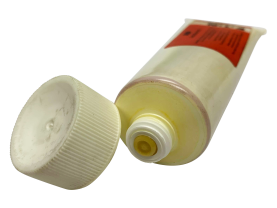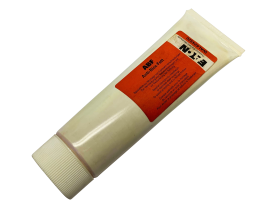Anti-bloc Fett
|
Anti-bloc fett are sealants used to seal pipes and other installations. They are widely used in several manufacturing and production machines such as in fluid conveyance systems, hydraulic circuits, and other pipe connection systems. Anti-bloc fett, shortened as ABF, is made of petrochemical hydrocarbons that are capable of metal-to-metal connection sealings. The anti-bloc fett, when in use, displays a double-edge cutting ring that yields a top-performing seal.
Furthermore, the unique makeup of the double-edge cutting yield makes the installation of machines much quicker and easy. |
|
Function |
Installation of stainless couplings of material Stainless Steel SS316 in order to avoid gripping and to reduce the friction's coefficient |
CATALOGUE :
What are Anti-bloc Fett
 Anti-bloc Fett / Grease
Anti-bloc Fett / Grease
1. What is an Anti-bloc Fett?
Anti-bloc fett is a powerful sealant used in high-level industrial applications. Sealants are play an important part during pipe, tube, flange, or hose connections. They help to fill minute gaps that may exist during metal-to-metal connection.
Anti-bloc fett comes in handy during such connections as they serve as both grease and sealant. This is because ABF reduces the friction between metal surfaces when the machinery is in operation, while also closing gaps that may exist. The material, made up of anti-bloc fett, ensures that there is a possibility of leakage in the system.
Anti-bloc fett comes in various sizes. The large size is stored in cans and has a mass of 1000g. You can also get smaller variants in a 100g size. The anti-bloc fett is particularly a recommended sealant when working with machinery that would operate between 100 degrees Celsius to 400 degrees celsius. Both, however, that is it is not advised to use Anti-bloc fett is not advised in equipment that processes drinking water or other drinking fluids.
Anti-bloc fett is a powerful sealant used in high-level industrial applications. Sealants are play an important part during pipe, tube, flange, or hose connections. They help to fill minute gaps that may exist during metal-to-metal connection.
Anti-bloc fett comes in handy during such connections as they serve as both grease and sealant. This is because ABF reduces the friction between metal surfaces when the machinery is in operation, while also closing gaps that may exist. The material, made up of anti-bloc fett, ensures that there is a possibility of leakage in the system.
Anti-bloc fett comes in various sizes. The large size is stored in cans and has a mass of 1000g. You can also get smaller variants in a 100g size. The anti-bloc fett is particularly a recommended sealant when working with machinery that would operate between 100 degrees Celsius to 400 degrees celsius. Both, however, that is it is not advised to use Anti-bloc fett is not advised in equipment that processes drinking water or other drinking fluids.
2. How to apply Anti-bloc Fett / Grease during Installation?
Applying the anti-bloc fett is a simple process during installation. The steps described below gives a blueprint on how to apply Anti-bloc grease to a tube connection.
Step 1: Measure the length of the tube
The first thing to do is to determine the length of the tube you wish to fit your desired length. Remember that this length should fit the other components of the assembly. You should take note of the following when measuring the tube length.
It is important to point out that depending on the material you are using, the tube length determinant may vary. Stainless steel for instance has a tube length determinant of 1.4571. Be sure to consider this factor when specifying your tube length.
Step 2: Cut the tube
Next thing is to cut the tube. During the process of delivery, tubes may get damaged at different points especially the edges. It is good practice to cut off these deformations 10mm away. The tube should be cut at 1/2’’ angle to the tube axis. Also, be sure to use the proper cutting equipment to ensure a smooth and straight cut. Cut-off saws and pipe cutters are not advisable.
Step 3: Clean the tube
You will need to clean the inner and outer surface of the tube to make sure it is free of particles or dirt. The clamping region needs to be free of oil or any grease. You can use a mild solvent to clean off oils if they exist.
Step 4: Apply the anti-bloc fett on the tube
Now, apply the grease to the connecting surfaces. You could use a brush or lint-free fabric to ensure it is evenly applied. Immediately after anti-bloc fett application, join the connecting surfaces, so that it does not get contaminated by dirt or debris.
Applying the anti-bloc fett is a simple process during installation. The steps described below gives a blueprint on how to apply Anti-bloc grease to a tube connection.
Step 1: Measure the length of the tube
The first thing to do is to determine the length of the tube you wish to fit your desired length. Remember that this length should fit the other components of the assembly. You should take note of the following when measuring the tube length.
- Measure the length of the tube studs at both ends.
- Add the desired gap between two studs facing each other.
It is important to point out that depending on the material you are using, the tube length determinant may vary. Stainless steel for instance has a tube length determinant of 1.4571. Be sure to consider this factor when specifying your tube length.
Step 2: Cut the tube
Next thing is to cut the tube. During the process of delivery, tubes may get damaged at different points especially the edges. It is good practice to cut off these deformations 10mm away. The tube should be cut at 1/2’’ angle to the tube axis. Also, be sure to use the proper cutting equipment to ensure a smooth and straight cut. Cut-off saws and pipe cutters are not advisable.
Step 3: Clean the tube
You will need to clean the inner and outer surface of the tube to make sure it is free of particles or dirt. The clamping region needs to be free of oil or any grease. You can use a mild solvent to clean off oils if they exist.
Step 4: Apply the anti-bloc fett on the tube
Now, apply the grease to the connecting surfaces. You could use a brush or lint-free fabric to ensure it is evenly applied. Immediately after anti-bloc fett application, join the connecting surfaces, so that it does not get contaminated by dirt or debris.
3. What are the tightening torque values for the tubes?
Refer to the table shown below for the torque values for steel and stainless steel materials.
Refer to the table shown below for the torque values for steel and stainless steel materials.
Series L
Tube OD (MM) |
Steel (Nm) |
Stainless Steel (1.4571) (Nm) |
6 |
30 |
30 |
8 |
35 |
35 |
10 |
40 |
40 |
12 |
55 |
55 |
15 |
80 |
80 |
18 |
110 |
120 |
22 |
140 |
170 |
28 |
210 |
250 |
35 |
300 |
380 |
42 |
400 |
520 |
Series S
Tube OD (MM) |
Steel (Nm) |
Stainless Steel (1.4571) (Nm) |
6 |
35 |
35 |
8 |
40 |
40 |
10 |
55 |
55 |
12 |
70 |
70 |
16 |
110 |
110 |
20 |
150 |
170 |
25 |
210 |
260 |
30 |
280 |
370 |
38 |
410 |
590 |
 Anti-bloc Fett / Grease
Anti-bloc Fett / Grease
4. What are the applications of Anti-bloc Fett / Grease?
Anti-bloc fett/grease finds application in a myriad of industries.
Anti-bloc fett/grease finds application in a myriad of industries.
- In machine building, it is used on CNC machining, metal stamping, hydro/metal forming, etc
- In mining, they are used on conveyors, excavators, coal mill, foundry casting, stacker, mobile crusher, etc
- In mobile equipment, they are used on cranes, lift trucks, compactor, mowers, tractors, pavers, skidders, balers, etc
CATALOGUE :

